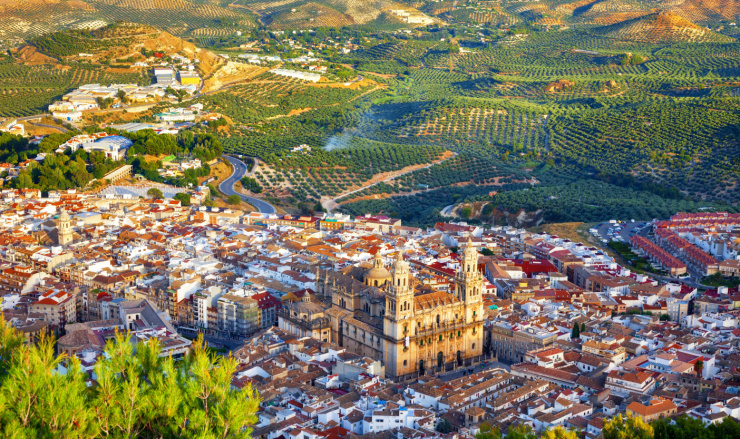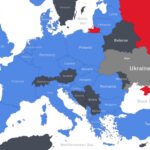
Bird view of Jaén city surrounded by olive groves. Assumption of the Virgin Cathedral is highlighted by the last rays of sunset. Andalusia, Spain. By Ivan Soto Cobos @ Shutterstock.com
Despite what many consumers of olive oil may believe, neither Italy nor Greece, or even Turkey, are the world’s largest producers. No. The world’s largest producer of olive oil is Spain. James Jeffrey discusses Spain’s olive oil industry in Spectator World, writing:
It was an extraordinary sight. For three days, and about seventy kilometers of hiking, there were just endless olive trees covering the fields, hills and mountains stretching to the horizon of the small Spanish province of Jaén. Tucked away in the southern region of Andalusia, this is the country’s powerhouse of olive-oil production.
Many people assume Italy or Greece are the largest producers of olive oil. That’s a result of good branding and name recognition, a Jaén-based olive grower told me. After he pulled up alongside me in his dusty car, we walked through the endless olive groves as I was given a tutorial on olive oil production.
Spain is the world’s top producer of olive oil. And most of its olives come from Jaén, which has nearly one and a half million acres of olive groves and more than 66 million trees. At about 5,200 square miles, Jaén is smaller than Connecticut, yet it produces 20 percent of the world’s olive oil. My tutor claims the figure is closer to 40 percent. Even at the lower end of the range, that’s more than the whole of Italy produces, while much of what Italy exports is actually Spanish in origin. Jaén calls itself the “World Capital of Olive Oil” — and is entirely justified in doing so.
So unending is the expanse and relentlessness of those olive groves, I might as well have been at sea. The curve of each treetop stands out like the crest of a wave; the rolling landscape is parsed by streams and rivers that nourish the trees, and whitewashed villages and towns nestle amid the green.
It was all fascinating, particularly when it came to learning how olives are harvested. The harvesters use handheld machines that look like leaf blowers with rubber hooks on the end. After the engine is cranked, the hook vibrates violently around the tree’s slim trunk, shaking it into a frenzy. Olives cascade down onto a tarp, while another worker with a leaf blower and a rake clears off debris and creates what looks like shallow pyramids of black marbles.
This was February, and the Andalusian weather was chilly but sunny. All along my route, workers waved out from beneath the olive trees, and I waved back. One worker asked me to take a photo of him proudly clasping his tree shaker.
Olive growing in Jaén dates back 2,000 years. Olives were cultivated first by the Phoenicians and then by the Romans, who transported the produce to Seville, where it was loaded onto boats that sailed along the breadth of the Guadalquivir to the bay of Cádiz. There the boats looped down and around through the strait of Gibraltar toward Rome and around the world.
In addition to olive trees, Jaén also has one of the world’s highest concentrations of castles thanks to its strategic position during the Reconquista, when Catholic monarchs wrestled back control of southern Spain from the Moors. My day’s trek through those endless olive groves typically ended up in a small town built defensively in the lee of a mountain. It would feature a castle atop a hill overlooking the surrounding plains, with a beautiful church alongside it. Directly below would be a patchwork of narrow and often very steep alleyways.
Read more here.
If you’re willing to fight for Main Street America, click here to sign up for my free weekly email.





